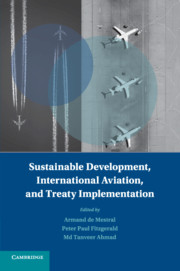Book contents
- Sustainable Development, International Aviation, and Treaty Implementation
- Treaty Implementation for Sustainable Development
- Sustainable Development, International Aviation, and Treaty Implementation
- Copyright page
- Contents
- Figures
- Tables
- Contributors
- Introduction
- Part I Current Status of Global Aviation and Sustainable Development
- Part II Regional Aviation Issues
- Part III Dispute Settlement
- Part IV Future Directions
- 12 Getting to Global Cooperation
- 13 Seeking Global Environmental Harmony in Aviation
- 14 Inspirations from Sustainable Maritime Development
- 15 Corporate Social Responsibility in the Aviation Industry
- Conclusion
- Index
13 - Seeking Global Environmental Harmony in Aviation
from Part IV - Future Directions
Published online by Cambridge University Press: 22 August 2018
- Sustainable Development, International Aviation, and Treaty Implementation
- Treaty Implementation for Sustainable Development
- Sustainable Development, International Aviation, and Treaty Implementation
- Copyright page
- Contents
- Figures
- Tables
- Contributors
- Introduction
- Part I Current Status of Global Aviation and Sustainable Development
- Part II Regional Aviation Issues
- Part III Dispute Settlement
- Part IV Future Directions
- 12 Getting to Global Cooperation
- 13 Seeking Global Environmental Harmony in Aviation
- 14 Inspirations from Sustainable Maritime Development
- 15 Corporate Social Responsibility in the Aviation Industry
- Conclusion
- Index
Summary
Over the last twenty years the number of flights has mushroomed, increasing GHG emissions from airlines and causing crowded skies and congested airports. Competitor jets follow each other across the sky and where an airline might have served a route with two planes in 1992, today it uses three. Both of these practices are routed in theories that argue that business travelers will prefer the airline with more frequent flights.
Proposed aircraft like the 300-seat Large Aircraft for Short Range (LASR) with the potential to dramatically reduce greenhouse emissions cannot emerge in the current climate. This chapter is motivated by regulatory decisions that have supported Metal Neutral Joint Ventures in North America and Europe and by capacity sharing arrangements between competitors on domestic routes in the United States and Mexico in the 1970s and 1980s. Just as such arrangements were used to provide greater consumer choice, it will be proposed that such arrangements could be used in current circumstances to reduce both the GHG impact of a flight and the amount of congestion in our skies.
This chapter proposes legal structures that would facilitate the sharing by two or more airlines of the same large aircraft. It ensures that any inter-carrier arrangement would promote competition between them and further proposes that environmental benefits, in particular a reduction in GHG emissions, be considered as part of any analysis to grant antitrust immunity to a joint venture or merger.
- Type
- Chapter
- Information
- Publisher: Cambridge University PressPrint publication year: 2018



